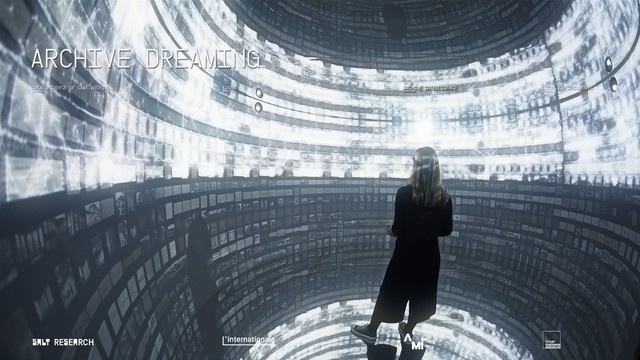ARCHIVE DREAMING 2017, Turkey, ISTANBUL
ARCHIVE DREAMING






Archive Dreaming explores data and machine learning, letting you examine 1.7 million documents, their information and connections, but when idle it visualizes ‘dreams’ of documents with neural networks within architectural immersive environment.
Created by Refik Anadol Studio in collaboration with Google’s Artists and Machine Intelligence program, and installed at the SALT Gatala, Istanbul / Turkey, Archive Dreaming is a 6 meters wide circular installation that employs machine learning algorithms to search and sort relations among 1,700,000 documents. Presented as part of The Uses of Art: Final Exhibition with the support of the Culture Programme of the European Union, the installation is user-driven but when idle, the installation “dreams” of unexpected correlations among 1.7 million documents from 17th-20th century Ottoman Bank’s Cultural Archive.. The resulting high-dimensional data and interactions are translated into an architectural immersive space. The idea was to organize the documents by the conceptual appearance. To do this the team fed each image through a general purpose image recognition network. Rather than using its final classification, the activations of a neural layer or two prior is extracted. This is a 1024 dimensional vector, called an “embedding”, which describes the image contents in terms of high level conceptual features, 1024 features to be precise. They calculated such an embedding for all 1.7M images in the archive. To make this space renderable they needed to reduce the dimensionality from 1024 to two or three. This is where the tSNE algorithm comes in – it tries to arrange the points from the high dimensional space into a 2D plane or a 3D volume while maintaining the close neighbors of each point. This means that images that were close in 1024 dimensional space, by virtue of sharing high-level visual similarity, also end up close to each other in the 2D or 3D projection. One of the technical challenges of the project was the real-time rendering of 1.7 million images. As a solution, graphics programmer David Gann implemented a dynamic level of detail (DLoD) system in vvvv, a tool well suited for graphic intensive interactive media installations. The modular DirectX 11 library
http://refikanadol.com/works/archive-dreaming/
Details
Building or project owner : REFIK ANADOL
Architecture : REFIK ANADOL & RAMAN K. MUSTAFA
Project artist/ concept/ design/ planning : REFIK ANADOL
Structural engineering : SALT
Facade design : SALT
Facade construction : SALT
Kinetic engineering : SALT
Light design : REFIK ANADOL STUDIO
Technical layout light : REFIK ANADOL STUDIO
Display content/ visuals/ showreel : REFIK ANADOL STUDIO
Light hardware (LED hardware) : REFIK ANADOL STUDIO
Lighting control software : REFIK ANADOL STUDIO
Project co-ordination : GOOGLE AMI
Interaction design/ programming : REFIK ANADOL STUDIO
Project sponsor/ support : SALT
Descriptions
Kind of light creation : LASER PROJECTION TECHNOLOGY. 12K LUMINANCE X 4 CHANNEL USING CUSTOM SOFTWARE FOR EDGE BLENDING
Resolution and transmitting behaviour : 6200 X 1200PX
Urban situation : TEMPORARY MEDIA ART INSTALLATION IN A PUBLIC RESEARCH LIBRARY
Description of showreel : DOCUMENTATION OF THE EXPERIENCE
Participatory architecture & urban interaction
Community or communities involved : Public Archive Researchers, students, phd students, archivists, architectural urban researchers, history researchers, designers, media artists, artists, teachers, academicians,
Host organization : SALT
Issues addressed : What are the urgent conditions, responsibilities, meanings and futuredirected objectives for a cultural institution functioning in the ‘future’ year 2017? By attempting to consider these concerns along with questions of efficiency, ecology and sustainability, SALT’s 2017 program provisionally titled What If...? will be composed of a series of changes to internal working practices, accompanied by five artistic interventions/architectural gestures that reconsider, reinvigorate the spaces, the ambitions and the constituent relations within SALT Galata. The question being: What if... we implement a range of changes within the institution that introduce ideas we often talk about but that seem too extraordinary, too spatially absurd, too virtual or quite the opposite too practical to be considered exhibition programming. What if... we imagine 2017 is the future?
Impact : 40.000 PEOPLE VISITED. MORE OF THE VISITORS ARE RESEARCHER WITH PHD DEGREE TO ENHANCE THEIR COGNITION ON SEVERAL CULTURAL RESEARCH AREA MACHINE LEARNING ALGORITHMS HELPED US TO EXPLORE THIS INVISIBLE UNIVERSE OF ARCHIVE AND REVEALED MANY UNIQUE RELATIONSHIPS
Tools developed : CUSTOM MACHINE LEARNING ALGORITHMS CUSTOM SOFTWARE FOR LOADING MILLIONS OF IMAGES CUSTOM SOFTWARE FOR INTERACTION WITH DATA UNIVERSE
Tools used : MACHINE LEARNING ALGORITHMS CUSTOM SOFTWARE DIGITAL ARCHIVE MANAGEMENT METADATA MANAGEMENT
Next steps : VR INSTALLATION TO BRING BOTH PHYSICAL AND VIRTUAL WORLDS OF ARCHIVE TOGETHER
Mediacredits
Refik Anadol
Refik Anadol
Refik Anadol
Refik Anadol
Refik Anadol